In 2005, Richemont Officine Panerai surprised its aficionados with an outstanding “Special Edition”, the PAM 203. According to Richemont’s press release, the watches were equipped with historic “NOS” (New Old Stock) Angelus 240 movements that were “supposedly” found in the old stock of the original company.
It turns out this information was totally misleading. A closer look reveals that these movements have only little in common with the original units that were installed by G. Panerai e Figlio in the 1950s/1960s. Officine Panerai S.p.A. had bought respectively traded these movements from an Italian source only in 1996, just before the takeover by Cartier/Vendôme.
PAM 203 Angelus 240 units are not “historic” Angelus movements. New findings have uncovered a well guarded secret. PAM 203 movements are based on cheap key-winding units from old table clocks that were subsequently converted to crown-winding units by using replicated Angelus parts.

.

.
For collectors and fans of the brand, these “historic” Angelus 240 movements were definitely the most desiderable feature of these watches. In a press release from 2005, Richemont Officine Panerai stated:
The movements have been completely restored to new condition, with all parts being overhauled or renewed.
and
These 150 units restored by Panerai are uniquely rare, and at the same time they revive the glorious past of this movement.
Link: Read the whole press release text here (Paneristi.com)
.
ThePuristS.net wrote in April 2005:
Limited to 150 pieces. Panerai says that they found these movement in their stock. Due to rust and bad conditions of keeping it took the watchmakers over 2 years to restore these movements which are now available in this beautiful new watch which can be only purchased in a Panerai boutique.
.
For many Panerai enthusiasts the iconic PAM 203 is the ultimate modern “Holy grail”, the best of both worlds, vintage and contemporary. A safe haven with box and papers. The watch is without doubt one of the pillars of modern Panerai under the umbrella of the Richemont Investment Group.
The method of distribution was as unique as the watch itself. The entire edition of 150 pieces was sold for USD 18.000 each to handpicked customers through the Officine Panerai Boutique in Florence. Mr. Angelo Bonati, CEO of Richemont Officine Panerai, apparently personally selected “true” Panerai collectors in order to avoid “flippers”.
The list of prospective buyers was long and after the selection was made many came away empty-handed and disappointed. In 2008, Richemont Officine Panerai released another Special Edition with the very same movement, the PAM 267. Only 6 pieces were made.

.
It is said that Richemont Officine Panerai spent 2 years in refurbishing the movements.
There have been speculations in the past whether the Angelus 240 movements used in the PAM 203 and PAM 267 are real vintage movements or replicas, due to their excellent condition. After an in-depth analysis I can clearly say that they are not replicas… Well, at least not completely.
To understand what had to be done to get these movements into wrist watches we need to go far back to the year 1936, the beginning of the Angelus 240 caliber.
.
The provenance of the Angelus 240 movements
Stolz Frères in Le Locle, the owner of the Angelus brand, introduced the Angelus 240 caliber in 1936 for the use in travel and table clocks. The caliber was available in 4 different configurations:
- Simple, non-alarm, key-winding (SCI)
- Simple, non-alarm, crown-winding (SRI)
- Alarm, key-winding (RCI)
- Alarm, crown-winding (RRI)
The following images show the 4 versions of the Angelus 240 that were available from the start. Please note that these are early movements produced approximately between 1936 and 1945.

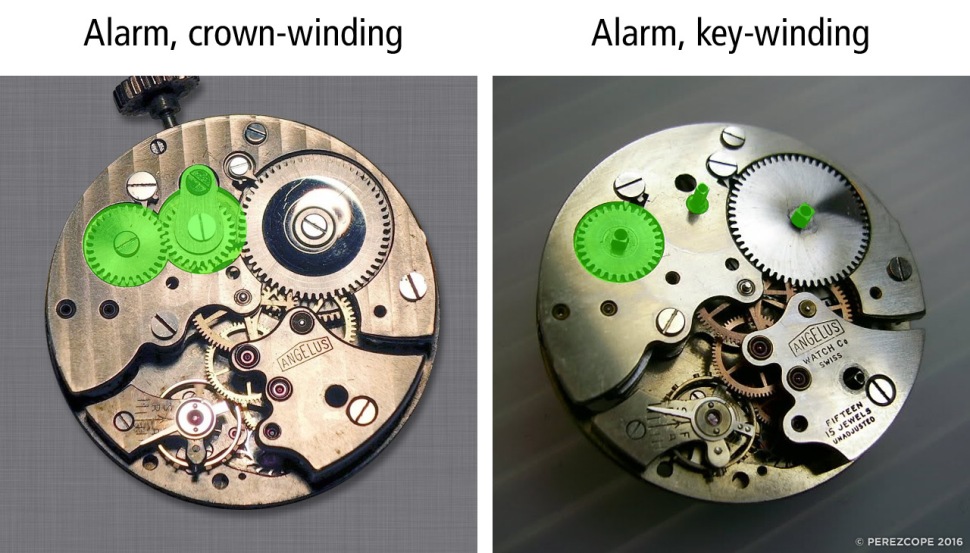
.
Over the course of its production span, the caliber was also offered in different quality grades, mostly concerning the finish/adornments of the bridges and whether it had a Breguet hairspring/Glucydur balance wheel or not.
The caliber received several technical updates and also the design on the balance wheel changed sightly over time, which gives us a good indication of the production dates.
.
Key-winding movements were less complicated and accordingly, less costly than sophisticated crown-winding units.

.
The back cover of alarm movements (crown-winding and key-winding) served also as “alarm bell”. This cover was attached to the center of the movement with 3 screws through a small extra bridge. The movement was fixed to the clock frame from the dial side.

.
Non-alarm movements used common casing screws (1, 2) through holes which are positioned 180 degrees from each other at the edge of the barrel bridge.
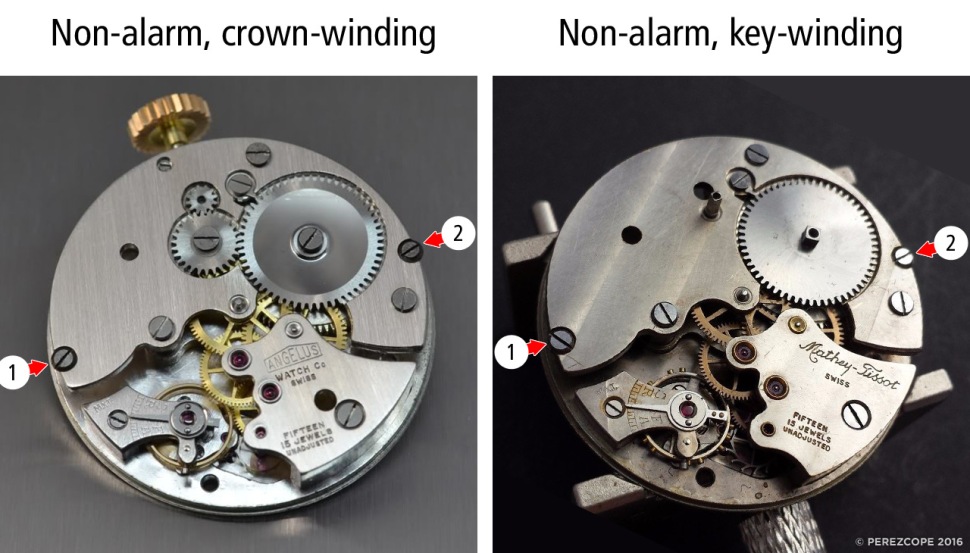
.
Stolz Frères introduced a new click spring (long click) in 1947/48 and as a result one casing screw hole on non-alarm movements had to be slightly moved (2). The next image shows a non-alarm, crown-winding movement vs. a non-alarm, key-winding movement for a very important reason.
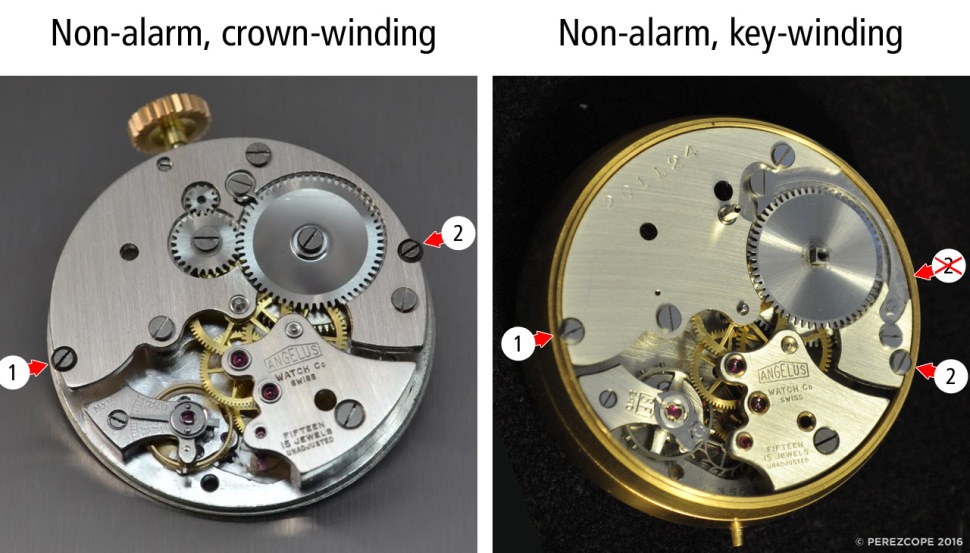
.
Following the results of my research, Stolz Frères discontinued non-alarm, crown-winding units in 1942/43 due to lack of demand. Alarm movements had become more conventient, especially in travel clocks and portable weather stations.
In Ehlers & Wiegmann’s publication “Vintage Panerai – The References”, the authors state on page 1215 that Stolz Frères produced a total of around 350 non-alarm, crown-winding movements.
The 350 or so movements made differ in terms of the lack of an alarm function, a modified winding mechanism (crown instead of a winding key) and a differently formed bridge from the carriage and table clocks previously mentioned. Around 90% of these movements were supplied to Guido Panerai & Figlio. In addition to Guido Panerai & Figlio, Mathey-Tissot also used this special type of movement in some watches that were supplied to Tiffany & Co. for the American market.
These numbers are far-fetched to say the least and the whole text was just copied from a forum post, where someone simply “guessed” a figure. Non-alarm, crown-winding movements were of regular production from the very start in 1936 and probably a low cost alternative. At some point, non-alarm, crown-winding movements simply became obsolete. A travel clock without alarm function is not very convenient, is it?

.
However, in decorative table clocks, where the units were integrated in globes etc., a protruding crown would have been disturbing anyway. These applications were exclusively equipped with less complicated non-alarm, key-winding Angelus 240 movements.

.
In March 1955, Stolz Frères introduced a slightly redesigned barrel bridge for the remaining 3 available Angelus 240 configurations.

.
G. Panerai e Figlio started to use Angelus 240 movements after 1956 when the company developed its first “own” watch, the GPF 2/56. The original “Panerai” movements were special orders made by G. Panerai e Figlio to Stolz Frères SA in Le Locle.
For G. Panerai e Figlio, Stolz Frères SA produced 3 special series (12.55, MAI.61, JUIN.61) of Angelus 240 movements. The first series was eqipped with the Incastar micro regulation device, which Stolz Frères had introduced in 1949 for all Angelus 240 movements. Later series had a simple regulator with Incabloc. All movements were equipped with 17 instead of only 15 jewels. For the first time in history, Stolz Frères made Angelus 240 movements for the specific use in wrist watches.

.
A common misconception is that the Angelus 240 movements used in the PAM 203 and PAM 267 were old stock from the 1950s/60s that the old G. Panerai e Figlio and later Officine Panerai S.p.A. had in their shelfs in Florence. Unfortunately this is not the case.
In June 2009, it became very clear where these movements (190 in total) originated from. After doubts about their originality had been expressed on the Paneristi forum, Francesco Ferretti, one of the first Panerai collectors and renowned Panerai dealer, posted a statement in which he declared, that he himself had sold these movements to the “old” Officine Panerai S.p.A. (Pre Vendôme) in February 1996. This deal occured before the take over by Vendôme Investment Group in March 1997. Officine Panerai S.p.A. under the lead of Dino Zei was struggling financially and paid Mr. Ferretti with watches (Pre V) instead of money. It is unknown why Officine Panerai S.p.A. felt the need to buy over these movements in such a difficult situation. Talks with Vendôme (Cartier) had already started in 1996 and it is possible that the “old” Panerai bought these units with the objective to raise their market value.
According to Francesco Ferretti, he was able to acquire these movements in the early 1990s from a merchant in Switzerland, together with many other calibers and complete Angelus and Imhof travel clocks. The whole lot, he continued, came from the liquidation trusts of Angelus and Imhof.
Ferretti declared that these movements had simply been serviced, the edges of the bridges had been polished to mirror finish and that a modification took place in order to attach a dial in a proper way. He assured that the movements remained “absolutely” original from the 1950s. He also included the original receipt from 1996.
Link: Mr. Ferretti’s statement (Paneristi.com)

.
Mr. Ferretti was mentioned in the booklet that came with the PAM 203. On the last page Richemont Officine Panerai thanked him for his technical advice.
In contrast to what was implied by Mr. Ferretti and according to the results of my research, it is nearly impossible that non-alarm, crown-winding movements were still available in the 1950s.
I found a post from April 2005 on the Paneristi forum, which lists the efforts that went into “restoring” these movements. Someone took note during the SIHH presentation.
Hello all,
from my notes of the SIHH presentation, describing the efforts that go into restoring the 150 NOS Angelus SF 240 calibre, fitted in the PAM203 (14.900 Euro, on sale from december 2005)
Restoration of the Angelus movement
Main Plate
circular graining on the dial side
circular graining under escapementBarrel bridge
re manufacturd and one ruby added,
chamfered & brushedGear-train bridge
chamfered
brushed
engraved 15 (fifteen) jewelsBalance bridge
chamfered
brushedPallet-cock
chamfered
brushedBarrel,barrel ratchet and crown wheel
soeillage (Radical decoration)Wheels
circular graining and giltSetting stem
re-manufacturedScrew heads
polished
.
Link: Read the full details on the Angelus restoration from 2005 (Paneristi.com)
According to the above statement, the barrel bridge was completely “re-manufactured” by Richemont Officine Panerai. This is very interesting and indeed absolutely consistent with the results of my research. I am surprised that Mr. Ferretti missed to mention this important fact in his statement from 2009. A crucial part of the movements is definitely not original.
Another part that is listet as re-manufactured is the setting stem. One would assume a NOS (New Old Stock) movement would come with this part, but apparently this was not the case.
.
The re-manufactured barrel bridge of the PAM 203
As apparently disclosed by Richemont during the SIHH presentation in 2005, the barrel bridge (1) is not an original Angelus part and was simply reproduced by Richemont Officine Panerai. This “new” bridge (1) was probably also the reason, why these movements were refinished to an extend where all the “vintage” feel was gone.

.
It has already been mentioned that Angelus introduced a new barrel bridge design in March 1955 (3.55). This is a very important fact. The original design with “waves” was dropped after almost 20 years to make way for a simplistic and modern approach with a straight line. Only the first arch/wave on the left side of the bridge was retained, the one which covers the alarm hammer in alarm movements.

.
The first Angelus 240 series delivered to G. Panerai e Figlio bear the date stamp “12.55” on the main plate. The interesting thing is that all 3 series produced for G. Panerai e Figlio still have the old “waved” barrel bridges, months after the new design had been introduced. There is a simple explanation for this pecularity.
The 3 series of Angelus 240 movements produced by Stolz Frères SA on specific request of G. Panerai e Figlio over 55 years ago, were assembled using old barrel bridges from 1942/43, before the production of non-alarm, crown-winding units stopped. Instead of producing new non-alarm, crown-winding barrel bridges, Stolz Frères SA simply “recycled” old bridges from their stock.
The evidence that Angelus used old bridges for the Panerai movements is all there:
- “Waved” barrel bridges in movements from 12.(19)55. MAI.61 and JUIN.61.
- Slot underneath the click (1)
- “Old” hole for the casing screw (2)
.

.
A side by side comparison of the original “Panerai” barrel bridge (right, JUIN.61) with an alarm, key-winding barrel bridge from 12.50 (December 1950) shows that the new long click spring did not require the deep slot (1) anymore.

.
Since the company had introduced a new “long” click spring in 1947/48, the old bridges for the Panerai movements were subsequently modifed (1) in order to be state of the art.
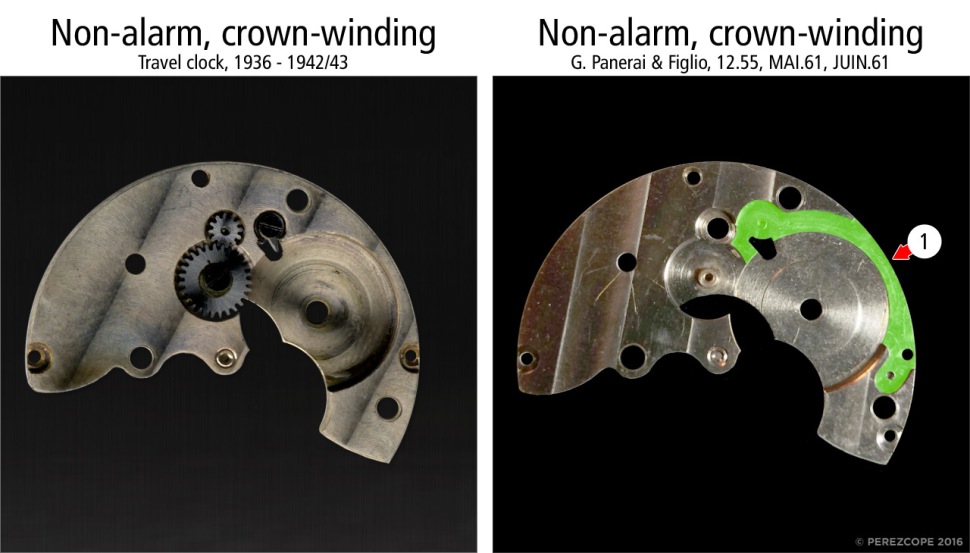
.
If we look at the PAM 203, the lack of a slot for the old “short” click system (1) makes it very clear that these bridges are not original, especially in combination with the “replicated” casing screw hole at the old position (2).

.
The original “Panerai” Angelus 240 movements were equipped with two extra jewels, one on the train gear bridge (3) and one in the main plate. PAM 203 movements have only 15 jewels. Where the original “Panerai” movements have the extra jewels, the PAM 203 units have “only” a typical clock bushing.
Clearly visible in the above picture is the different logo on the PAM 203. Interestingly there is a variety of logos and their position on the train gear bridge in PAM 203 watches. The specific logo with the disctinctive “edgy” S in the picture above (left, PAM 203) was only adopted in 1966.

.
The use of Angelus 240 in wrist watches had never been considered by Stolz Frères SA. Clock dials were usually attached directly to the frame. Therefore, there is no mechanism to attach a dial in the traditional way. For the PAM 203 and PAM 267, Richemont Officine Panerai had to drill two new holes into the main plate to make space for the dial feet. To reach the dial fixing screws from the bridge side of the movement, the barrel bridge was redesigned with two slots (1, 2).

.
In the old days, G. Panerai e Figlio used to fix the dial by using a hollow dial foot and a screw through the main plate (3). To release this screw it was necessary to remove the barrel bridge. A very time consuming procedure.
Another interesting observation on the barrel bridges of the PAM 203 is the lack of the “alarm barrel” center hole (4).
On the SIHH press release image from 2005 the hole is clearly visible but the area around the centre wheel looks strange. This was probably just a prototype.

.
Richemont Officine Panerai put a lot of effort into replicating these barrel bridges but compared to the original bridges they are not very accurate. However, since Richemont apparently disclosed the fact that the bridges were reproduced, the only question that arises is why was this step necessary? What happened to the original NOS (New Old Stock) bridges?
As we proceed looking into these movements, we will see that not only the bridges were reproduced but also much more essential parts.
.
Inner values
Most non-alarm components have a similar shape like alarm parts, obviously to simplify the production and keep the costs low.
A key component to understand the origins of these movements is the intermediate bridge that is located underneath the barrel bridge.
On a crown-winding movement the intermediate bridge is needed to take the stem and the whole winding and setting mechanism. Winding and sliding pinion (clutch wheel) are located inside the slot with the T shape.

.
This comparison shows that the intermediate bridges have the same basic shape in all configurations. On alarm movements the bridge has a recess to fit the alarm barrel (1). Main plates of alarm movements have more holes and slots. The recess underneath the alarm barrel (2) is meant for the alarm hammer mechanism. Clearly visible is also the extra jewel (3) in the main plate of the original “Panerai” Angelus. The other added jewel is in the train gear bridge.
Key-winding movements have an intermediate bridge that is only half the height of a crown-winding movement, since neither winding nor setting parts need to be installed.
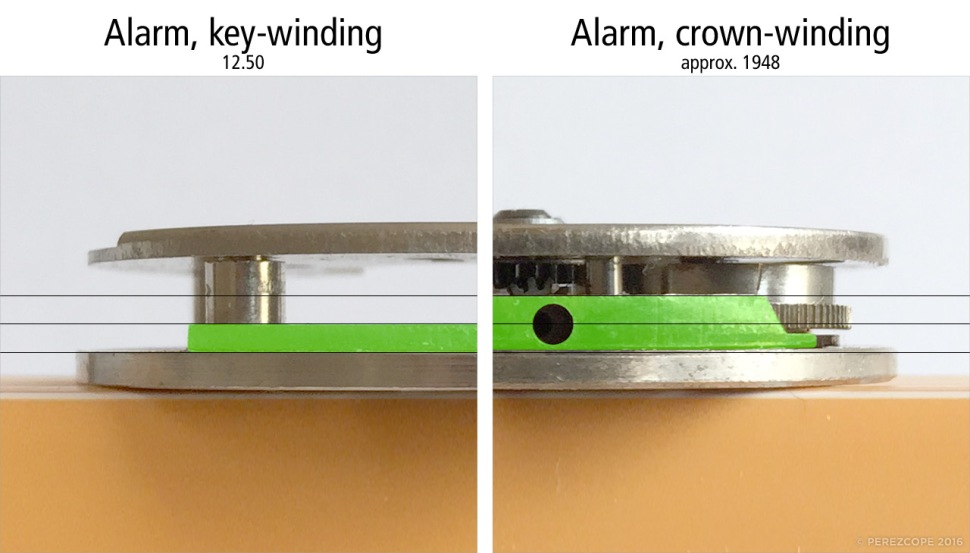
.
Surprisingly, a closer look at the intermediate bridge of PAM 203 Angelus 240 movements shows that the bridge has a noticeably different shape than usual movements.
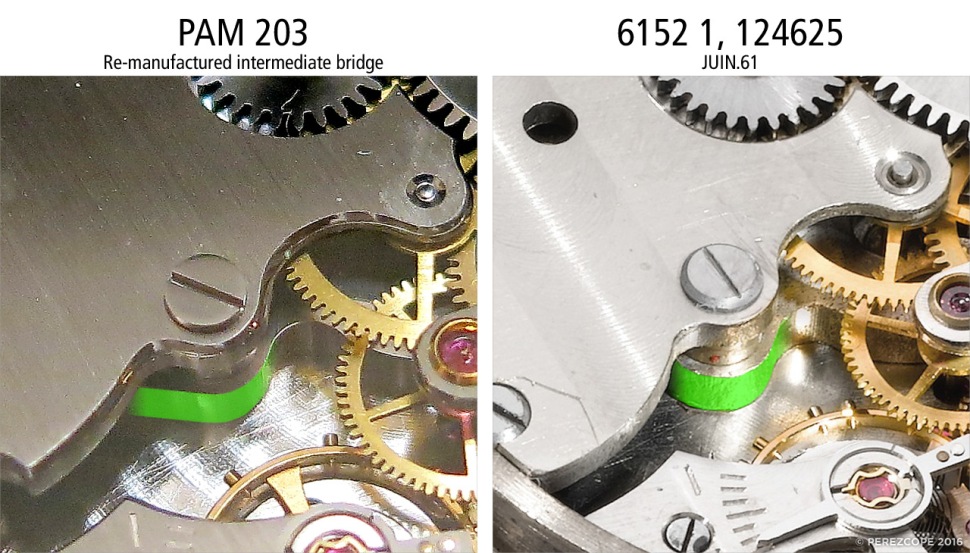
.

.
The following picture shows how the intermediate bridge of the PAM 203 probably looks like underneath the barrel bridge (left).

.
An intermediate bridge with this shape was definitely not made by Stolz Frères SA aka Angelus. This part is not original and there is only one logical reason why this specific bridge had to be “reproduced”. The original movements sold to Panerai S.p.A. in 1996 were most certainly key-winding units from table clocks, movements with absolutely no historical connection to the glorious past of G. Panerai e Figlio.
.
A converted key-winding movement
It is difficult to say what other parts were re-manufactured. All PAM 203 main plates I have seen so far appear to be from non-alarm movements (less holes). This could be an indication that the original key-winding movements were without alarm function. Richemont “removed” all visible date stamps and other marks with the extensive refinishing. This makes it difficult to asses the rest of the parts.
Besides the barrel bridge and the intermediate bridge, several other components had to be reproduced as well in order to convert these key-winding movements for the use in a wrist watch.
Such a “conversion kit” would consist of:
- Setting lever jumper
- Yoke spring
- Yoke
- Setting wheel
- Intermediate setting wheel
- Setting lever
- Setting lever scrwew
- Stem
- Winding pinion
- Sliding pinion (clutch wheel)
- Crown wheel
- Crown wheel washer
- Crown wheel with square hole
- Intermediate wheel
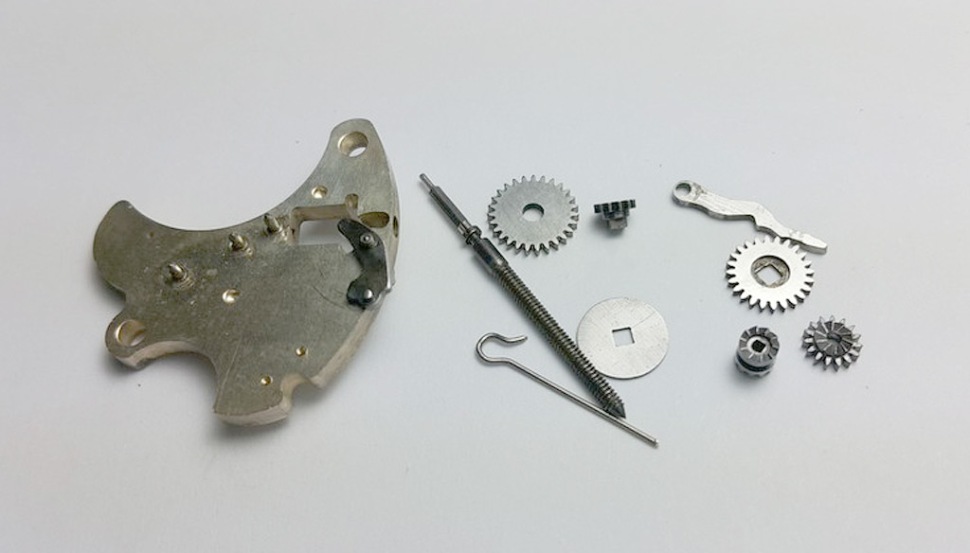
.
Thoughts
Why did Richemont Officine Panerai and Francesco Ferretti omit the true scale of modifications that went into building these movements for the PAM 203 and PAM 267? Would the truth about these movements have made a difference?
Angelus 240 key-winding units are not “uniquely rare”, as stated in the press release from 2005, they are actually quite common. Considering all the essential parts that had to be “re-manufactured” in order to convert these units for the use in wrist watches, only around 50% of the movement can be considered vintage, maybe even less. The originality is certainly lost. These movements are neither fish nor fowl.
The original G. Panerai e Figlio Angelus 240 movements from the 1950s and 1960s were produced on special request. With their pecularities, they are a true milestone in the history of Panerai and Angelus.
Thanks for your interest.
Read more: The evolution of the Angelus 240
Read more: PAM 21 with “vintage” Rolex 618
.
Please do not hesitate to comment and share your thoughts at the end of the page. If you have any question please use the comment function to get in touch with me. Comments are only displayed after approval.


Hello Jose
Excellent research & writing, thank you for your work.
My name is James Dowling & I am a writer working on another book on the history of Rolex during the Wilsdorf years.
I would like to contact you with regards to some information that I have.
Thanks again
James
LikeLike
Dear Jose, your articles are fascinating. Please keep writing. My brother and me (also a Panerai fan) use to share your material all the time.
LikeLike
the detail here is impressive!
LikeLike